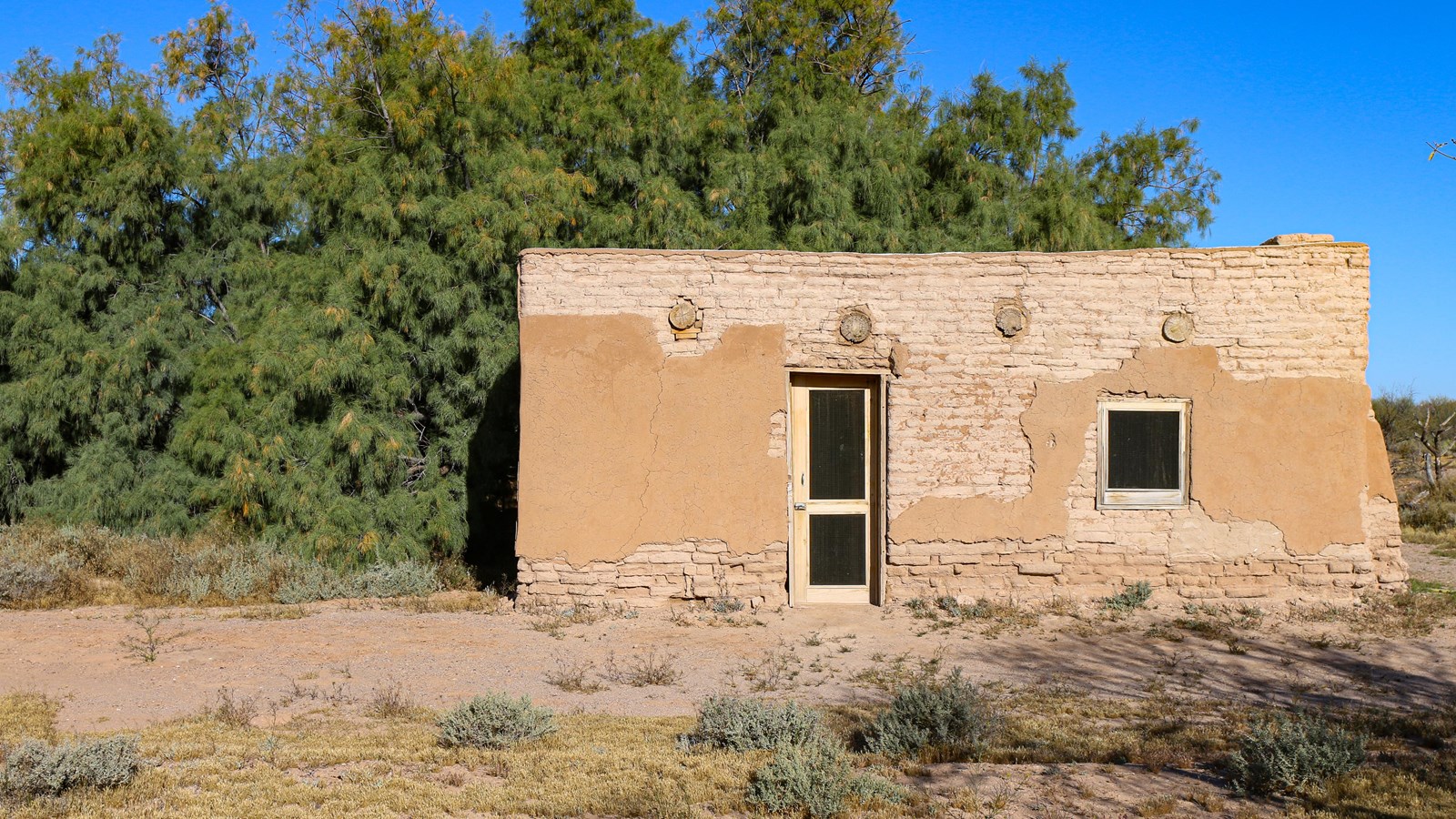Last updated: July 3, 2021
Place
Gachado Line Camp

NPS Photo/ K Ceballos
Quick Facts
Location:
2 miles east on the Camino de Dos Republicas
Significance:
Historic line camp that served the Gray’s vast cattle operation in the mid 1900s
Amenities
1 listed
Parking - Auto
How to get there
From the Visitor Center, head south on Highway 85 for approximately 5 miles. Look for a turn off on the left hand side of the road with a sign indicating the “Camino de Dos Republicas.” Continue on the Camino de Dos Republicas for 2 miles until you reach the small dirt parking area by Gachado Line Camp. Do not drive beyond Gachado Line Camp onto the border road and please do not approach or touch the border fence. This area is closed to the public.What’s a line camp?
A line camp is a place on the outskirts of a larger ranch for workers to stay. Line camps may also be located closer to the ranching operations so workers can keep a closer eye on their livestock. In this case, this line camp served Dos Lomitas Ranch run by the Gray family a couple miles to the east. Henry and Abe Gray, the two eldest Gray sons, built this line camp in 1921 and lived here for several years.Robert Lee (Bob) Gray bought the Blankenship ranch (now known as Dos Lomitas), wells, water rights, and cattle from Lonald Blankenship in 1919. Bob Gray and his sons built numerous structures and water facilities until their control extended over much of the Organ Pipe area.
Ranching in desert extremes
How were the Grays able to run cattle in a desert with so little grass? With the meager forage and water available, the Grays had to range their cattle over a very large area (over 350 square miles) to sustain their herd of cattle.With livestock scattered over such a large area, rounding up all these cattle would have been incredibly time consuming. However, the Grays pioneered a system where they operated a series of wells and water sources surrounded by mesquite corrals. In the dry seasons, cattle had to enter the corrals daily to drink. The gates were specifically constructed so that when they were closed, the livestock could enter the gate with a gentle push but could not exit. After the cattle were trapped in the corrals, they could be easily loaded onto a truck and sent to market.
This extensive grazing did not come without consequences for the desert. The cattle decimated the sparse vegetation and trampled vast areas, creating erosion and leaving the landscape overgrazed and barren. Even though cattle were removed from the monument in 1978, desert environments take a long time to recover. The damage is still visible in many areas, including those surrounding Gachado Line Camp.
What does “Gachado” mean?
“Gachado” means old twisted mesquite. While the original namesake mesquite is no longer present, the current large tree next to Gachado line camp is actually a nonnative tamarisk tree. Although tamarisks have a reputation of being highly invasive in other parts of the country, this subspecies is sterile and is the only tamarisk tree in the monument. Notice mounds of fine, dark sand underneath the tree. This site used to be an active Mexican Leafcutter Ant colony, and though this colony has long collapsed, several active colonies persist throughout the monument.Gachado Line Camp and Restoration
This adobe house exemplifies the resourcefulness of ranchers in the southwest. The building was originally made using mostly native materials. The Grays used ocotillo stems and organ pipe ribs to thatch the structure’s roof. Thick adobe walls were made from mud, grass and reeds found locally, and insulated the structure from the sweltering desert temperatures.This is an active restoration site. The foundation is original while the rest is under restoration. While adobe is effective insulation made from readily available materials, it also requires constant maintenance. For the Gray family, adobe upkeep was part of their regular chores. Since monument staff lack the resources to constantly maintain historic adobe, the restored bricks are made using a combination of mud, other natural materials, and Portland cement to hold the bricks together longer.
Learn more about the National Park Service’s work to restore Gachado Line Camp amidst the challenges of climate change.
The Gray Family and the National Park Service
When the monument was established in 1937, the Grays had been on the land for 17 years and were understandably threatened by its establishment, especially because lacked an official deed to the land.With the support of Senator Carl Hayden, in 1939, the Grays were able to obtain a lifetime permit to graze. The permit allowed them to have 550 cattle on monument lands. When the Park Service surveyed the cattle a couple years later, they found that the Grays had 1,600 cattle on park lands.
The ecological damage of long-term overgrazing created tenuous relations between the National Park Service and the Grays, and eventually the Department of Interior terminated the Gray’s grazing permit in 1968. Yet the Gray sons continued to run cattle on monument lands without a permit until the death of their last member in 1976.
When the last of the Gray brothers passed, it marked the end of cattle ranching in the monument. When the cattle were rounded up and removed in 1978, there were 1,700 cattle removed, which greatly exceeded the terms of the grazing permit.
